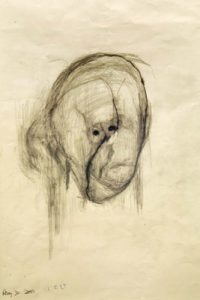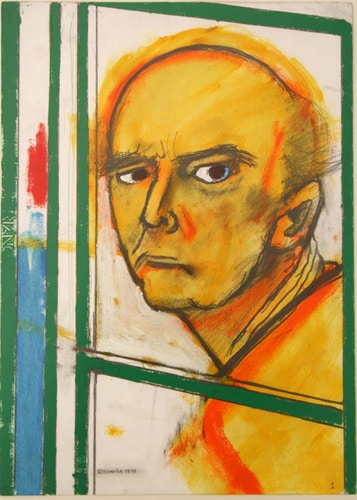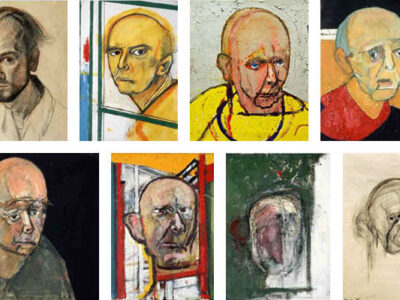All artists sign their work, however, by the end of 1999, William Utermohlen could barely remember his signature. Born in Philadelphia (1933), William was a famous American artist living in London until his death in 2007. His oil paintings are characterized by bright colors that are difficult to forget, and yet, one of his last works is made in a sober black and white: a pencil-on-paper self-portrait showing a disfigured face in which it is impossible to recognize Utermohlen himself. This drawing was made in 2000, four years after he was diagnosed with Alzheimer’s disease.

William Utermohlen died in 2007 after eleven years living with Alzheimer’s disease, which places him close to the 4-10 years that a person with Alzheimer’s lives on average, although survival after diagnosis is highly variable and ranges from one year to over twenty. Additionally, it is worth noting that, in retrospect, in many cases, it is possible to detect changes in patients before diagnosis.
Prodromal stage
U.S. President Ronald Reagan, who in 1994 announced he was suffering from Alzheimer’s disease, is a good example of this. Linguistic studies of his 1984 debates indicate that the disease was already beginning to develop: researchers detected Reagan’s speech was 9% slower, and he made up to five times more pauses and frequent minor errors in the use of articles, prepositions, and pronouns. The time interval when early symptoms emerge but they are not serious or apparent enough to make a diagnosis is called the prodromal stage, and can be seen not only in Alzheimer’s but also in other disorders such as schizophrenia.
In the case of Utermohlen, some experts suggest that signs of this prodromal period are apparent in the work of the early 90s, such as in the series titled “Conversation Pieces”, a total of six paintings of his life together with his wife Patricia. A detailed study allows us to observe changes in the spatial representation and disposition of objects and people which, in retrospect, are interpreted as the first signs of a neurodegenerative process.
Alzheimer’s and motor and sensory abilities
Apart from its long progression, an important characteristic of Alzheimer’s is that it does not affect all areas of the brain at the same time or with the same intensity; most frequently, the process begins in areas involved in the formation of new memories such as the hippocampus and the entorhinal cortex. From these areas neurodegeneration continues through the temporal lobe, which further damages memory as this region plays a critical role in memory storage, and from here continues to the prefrontal cortex. This is relevant because this disease—despite the fact that the stereotype focuses on memory symptoms—is not only about memory loss: damage to the prefrontal cortex alters basic mechanisms such as attention, emotional regulation, planning, etc., and further weakens the ability to recover memories. Finally, neurodegeneration ends up affecting motor and sensory abilities, although this usually occurs in the late stages.
Digitization in neuropsychological assessment
Marcos Ríos-Lago highlights the advancements, opportunities, and limitations of technology in the field of neuropsychological assessment, with a critical and integrative perspective. The omnipresence of technology in our lives Nowadays, we are surrounded by technology. Just a few days ago, we experienced a blackout that left us without electricity for several hours, allowing us to…
Continue Reading Digitization in neuropsychological assessment
Sleep neuroscience: how rest affects brain recovery and cognitive performance
To celebrate Brain Week 2025, this article explores how sleep affects cognitive function and how professionals can integrate this knowledge into their clinical practices. Introduction Sleep plays a fundamental role in brain health, directly influencing neuronal recovery and cognitive performance. In the field of neuropsychology, understanding the relationship between rest and brain processes is key…
Continue Reading Sleep neuroscience: how rest affects brain recovery and cognitive performance
Artistic skills and Alzheimer’s
This progression by brain areas is an advantage for artists as many of their skills depend on motor and sensory areas. This allows them to continue their profession for a relatively long period of time. There are documented cases of musicians who are still able to play certain melodies even in advanced stages of the disease. The same is true, for example, of painters such as Utermohlen, whose visual cortex took longer to be affected by the disease than parts involved in memory. For this reason, he was still able to paint even when he could no longer remember his own name clearly.
In view of all this, the case of William Utermohlen is not only an extraordinary graphic record of how a person experiences Alzheimer’s; it also reminds us that many artistic skills take time to be affected by Alzheimer’s and, therefore, painting or music may be hobbies that patients will be able to perform to some extent throughout much of the course of their disease.

References
- Arshavsky, Y. I. (2014). Alzheimer disease and cellular mechanisms of memory storage. Journal of Neuropathology and Experimental Neurology, 73(3), 192–205.
- Arshavsky, Y. I. (2010). Why Alzheimer’s disease starts with a memory impairment: Neurophysiological insight. Journal of Alzheimer’s Disease, 20(1), 5–16.
- Bird TD. (2018). Alzheimer Disease Overview. Genes Reviewers
- Draaisma, D. (2012). Alzheimer, supongo. Editorial Ariel.
- Casagrande, M., Agostini, F., Boncompagni, I., Cantone, M., Favieri, F., & Guarino, A. (2019). Executive Functions in Alzheimer Disease: A Systematic Review. Frontiers in Aging Neuroscience, 10 (January).
- Prince, M., Wimo, A., Guerchet, M., Ali, G. C., Wu, Y. T., & Prina, M. (2015). World Alzheimer Report 2015. London, UK. Alzheimer’s Disease International, 1–92.
- D. (2014). We are our brains. Penguin Random House
- William Utermohlen: https://www.williamutermohlen.org/index.php/homepage



 12 Effective neurorehabilitation activities to treat neurological diseases
12 Effective neurorehabilitation activities to treat neurological diseases
Leave a Reply